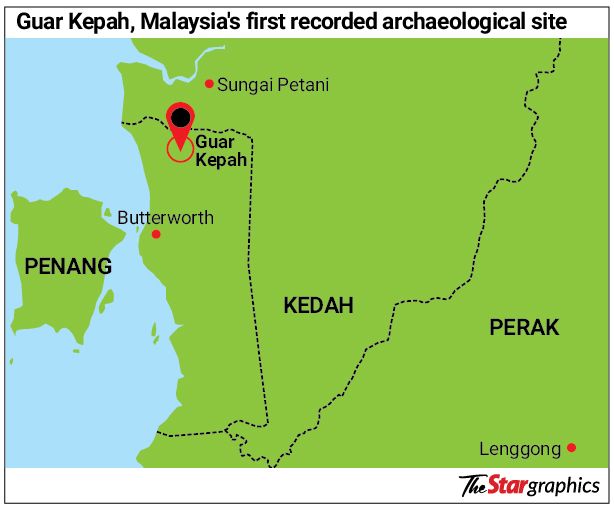GEORGE TOWN: It’s a homecoming after being away for about a century but their journey back to Malaysia will be a delicate adventure in itself.
The remains of 41 prehistoric people, discovered in Seberang Prai’s Guar Kepah archaeological site near the Kedah border between 1851 and 1934, would have to be handled with care all the way from the Netherlands where they have been “staying.”
“They are so fragile that any mishap can break them,” said Nurul Amira Md Isa, the curator of Chief Minister Incorporated (CMI), the project and landowner of the Guar Kepah site.
Guar Kepah is the first archaeological site recorded in Malaysia and is estimated to be between 5,000 and 6,000 years old.
It is considered unique in the country because it has shell middens, the prehistoric version of garbage dump sites.
Nurul Amira said the skeletons were ancient, so they face the risk of destruction by temperature, humidity, ultraviolet light and microbial life and certain gases.
An exhaustive list of procedures and testing was being done before the remains can be put on a plane in the Netherlands for their journey home, she said.
“First, we have to be certain that there will be minimal movement throughout the flight and transits,” she said in an interview.
She said suitable boxes or carrying cases were being prepared to safeguard each fragment of the skeletons while complying with all international and national regulations during repatriation.
These remains were unearthed by British archaeologists during excavations in Guar Kepah starting from the 19th to early 20th century.
It is unclear why they were sent to Europe, but it is believed that it was done so for research purposes since there were no experts here then.
Eventually, the remains were sent to the National Natuurhistorisch Museum in Leiden, Holland for safekeeping.
Scientifically, the remains are priceless because they hold secrets of a humanity that existed here for centuries before any kingdom was recorded.
Forensic and medical studies of the bones, teeth and any remaining human tissue could yield insights into the development of mankind in Penang’s prehistory.
Over the years, the state government has been trying to get the remains back on home soil.
In March this year, a delegation led by then Penang Deputy Chief Minister II Dr P. Ramasamy went to the Netherlands to discuss the repatriation of the artefacts.
ALSO READ: Unearthing more clues about the Pallava dynasty
Once the skeletons are back on Malaysian soil, they would have to deal with the tropical humidity and temperature.
Nurul Amira said the Guar Kepah Archaeological Gallery, which was being built now, would have strict specifications.
Special storage and exhibition areas with 24/7 lighting, temperature and humidity controls are an absolute must.
A strict protocol of handling procedures must also be observed to protect them from chemicals and microorganisms – bacteria and fungus – that could destroy them.
“It is vital to make sure the skeletons are protected from every possible harm once they are returned to Penang,” she added.
CMI general manager Datin S. Barathi said efforts to bring back the 41 skeletons are under the purview of the governments of Malaysia and the Netherlands.
“The last meeting we had with the National Heritage Department was in early August.
“The department and Foreign Ministry are working on it and after Cabinet approval, they will inform the state government,” she said.
Barathi added that all the documentation process would be managed by the Foreign Ministry with their Dutch counterparts before the skeletons can be brought home.
The Guar Kepah Archaeological Gallery is expected to be ready by the first quarter of next year, she added.
“We hope the skeletons can be brought straight to the gallery,” she said, adding that they could put it on public display about three months after that.
CMI, which is responsible for getting funds to set up the Guar Kepah Archaeological Gallery, will manage the site and gallery when it is opened to the public eventually.
Once the skeletons are back on home soil, they would undergo further analysis for an insight into ancient lives.
“But whether some of the skeletons will be exhibited would depend on their suitability and condition,” said Barathi.
As for the 42nd skeletal remains found in Guar Kepah in April 2017, known as ‘Penang Woman’, Barathi said it was now in Universiti Sains Malaysia’s (USM) Global Archaeology Research Centre under the care of its director Prof Dr Stephen Chia Ming Soon and his team.
Barathi said they hope to place the Penang Woman at the Guar Kepah gallery provided the conditions were conducive.
Since Penang Woman was unearthed much more recently, Barathi said the remains were scientifically even more important, so if the skeleton was found to be too fragile, only a replica of it might be shown in Guar Kepah.
Incidentally, ‘Perak Man’ is the remains of the country’s oldest prehistoric man. It was unearthed by a team from USM at Gua Gunung Runtuh in Lenggong Valley in 1991.
Perak Man is South-East Asia’s most complete human skeleton that has ever been found.




